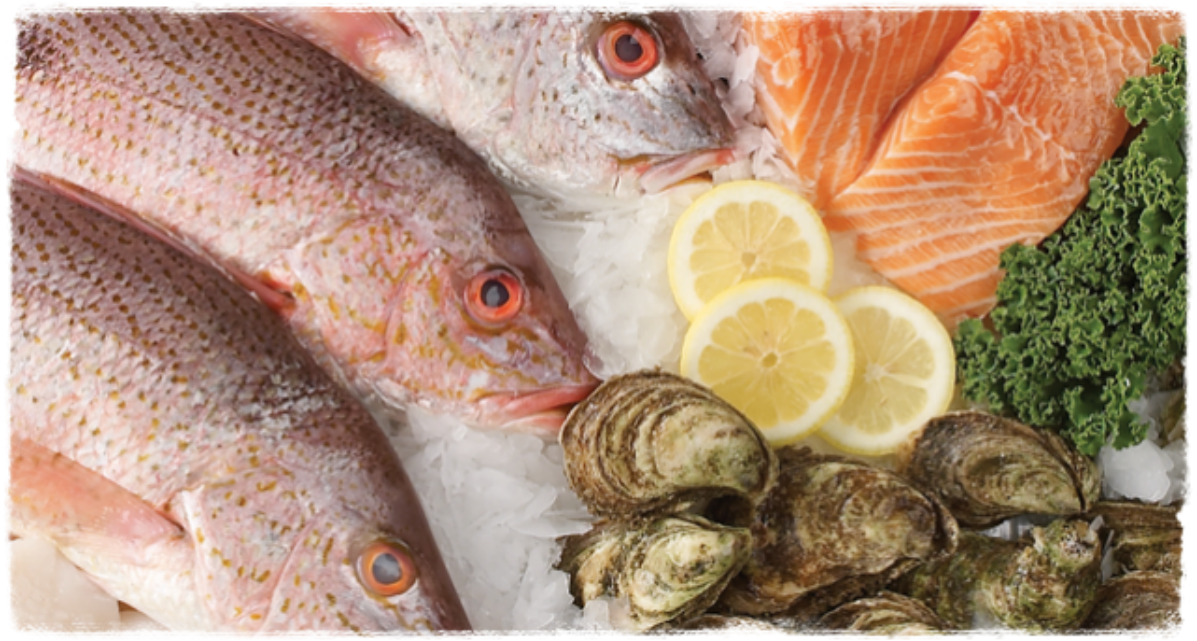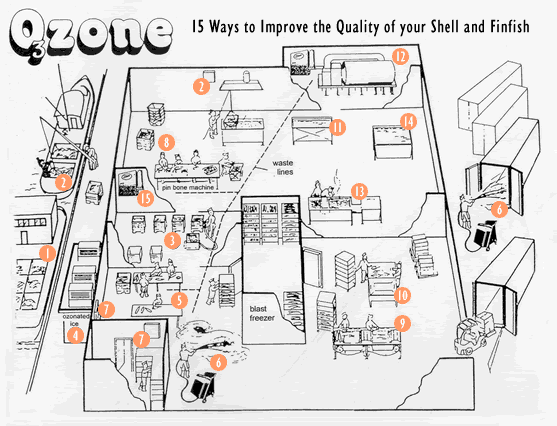Ozone for seafood processing & sanitation
Extends Seafood Shelf Life

Studies have shown that ozone is fifty one percent more powerful on bacterial cell walls than chlorine, and the disinfection rate is 3,125 times faster.
The fact that ozone leaves no residue in the water or on the product (it breaks down and returns to oxygen) results in no color or flavor change. Using ozone gives a higher level of assurance against pathogenic E-coli and similar organisms.
The Chemical Free Solution:
Ozone, a form of oxygen created by lightning bolts during a thunderstorm, also has the capacity to be harnessed in making seafood processing plants cleaner and doubling the shelf life of catfish. These were among research findings made by a Mississippi Cooperative Extension Service food scientist during the 20th annual Catfish Processing Workshop. The disclosed studies involving industrial ozone were in June and July 1990 at a catfish processing plant.
Experimenters determined that ozone was 15 times as effective as chlorine, extending shelf life by weeks, compared to the normal five to seven day shelf life.
Chlorine has proven to be ineffective in controlling bacterial growth, its use results in a poor shelf life of catfish and chlorine imposes a potentially harmful chemical on the consuming public.
Elimination of chlorine as the prime bactericide is now possible, along with other chemicals which may cause problems with treatment systems. Ozone offers the prospect of providing the consumer with a fish product that has added value and improved health benefits. The amazing thing is that ozone produced no after-effects and the product was cost effective to use. Ozone produces no detrimental chemical-organic reactions.
Ozone for food safety applies to all links in the food chain - from the processor to the table.
In keeping with the industry's intense resolve to produce a safe food product, using ozone will give processors an even greater assurance that their products are safe, as well as environmentally friendly. The fact that ozone leaves no residue in the water or on the product, (because it breaks down back to oxygen) means no change in color or flavor. Using ozone gives more assurance against pathogenic E-coli and similar organisms and at the same time, conserves water and extends the shelf life of the product.
Studies have shown that ozone is fifty one percent more powerful on bacterial cell walls than chlorine, and the disinfection rate is 3,125 times faster. FDA and ADEC has approved the use of ozone as a sanitizer for use in food processing plants.
There are two steps in most cleaning procedures. First, cleaning the surface areas and removing the organic residues in which the bacteria live. Secondly, sanitizing is done to destroy any bacteria remaining on the surface. No secondary biocide is necessary when using ozone as it kills bacteria, viruses, spores, fungi, mold, mildew, etc., without the need for other products.
In keeping with the industry's intense resolve to produce a safe food product, using ozone will give processors an even greater assurance that their products are safe, as well as environmentally friendly. The fact that ozone leaves no residue in the water or on the product, (because it breaks down back to oxygen) means no change in color or flavor. Using ozone gives more assurance against pathogenic E-coli and similar organisms and at the same time, conserves water and extends the shelf life of the product.
Studies have shown that ozone is fifty one percent more powerful on bacterial cell walls than chlorine, and the disinfection rate is 3,125 times faster. FDA and ADEC has approved the use of ozone as a sanitizer for use in food processing plants.
There are two steps in most cleaning procedures. First, cleaning the surface areas and removing the organic residues in which the bacteria live. Secondly, sanitizing is done to destroy any bacteria remaining on the surface. No secondary biocide is necessary when using ozone as it kills bacteria, viruses, spores, fungi, mold, mildew, etc., without the need for other products.
15 Ways to Improve your Seafood Processing Plant Using Ozone
- Marine Aqua Clean - Fish Tender use for RSW
- Marine Aqua Clean - Live Crab boats - ozone eliminates ammonia from holding tanks
- Big Chill Slush Maker - Will pump ozone slush ice up to 400 feet from the ice house
- Commercial Aqua Clean - Can be pumped to existing ice machines to create sterile ice for a safer, fresher product
- Commercial Aqua Clean - Slime Tables - Ozone dip removes bacterial slime from product
- Aqua Clean Mobile Sanitizer - Used for sanitizing wash down of equipment, walls, floors, trucks, etc.
- Ozone Air Clean - Will eliminate odors and airborne bacterial growth
- Commercial Aqua Clean - Ozone wash for fillets after removing pinbones
- Commercial Aqua Clean - Double dip Aqua Clean tanks, ozone Aqua Clean solution
- Ozone Air Clean - Vacuum packaging, using ozone gas
- Commercial Aqua Clean - Ozone chilled water for cooling cooked crab
- Commercial Aqua Clean - Meal plant using ozone water to control bacteria
- Commercial Aqua Clean - Shrimp peeling and cooling using ozone water
- Commercial Aqua Clean - Ozone refrigerated brine tank for shellfish product
- Commercial Aqua Clean - Feeds all water throughout the plant, up to 1500 GPM with a minimum of 2.0 parts per million of ozone









